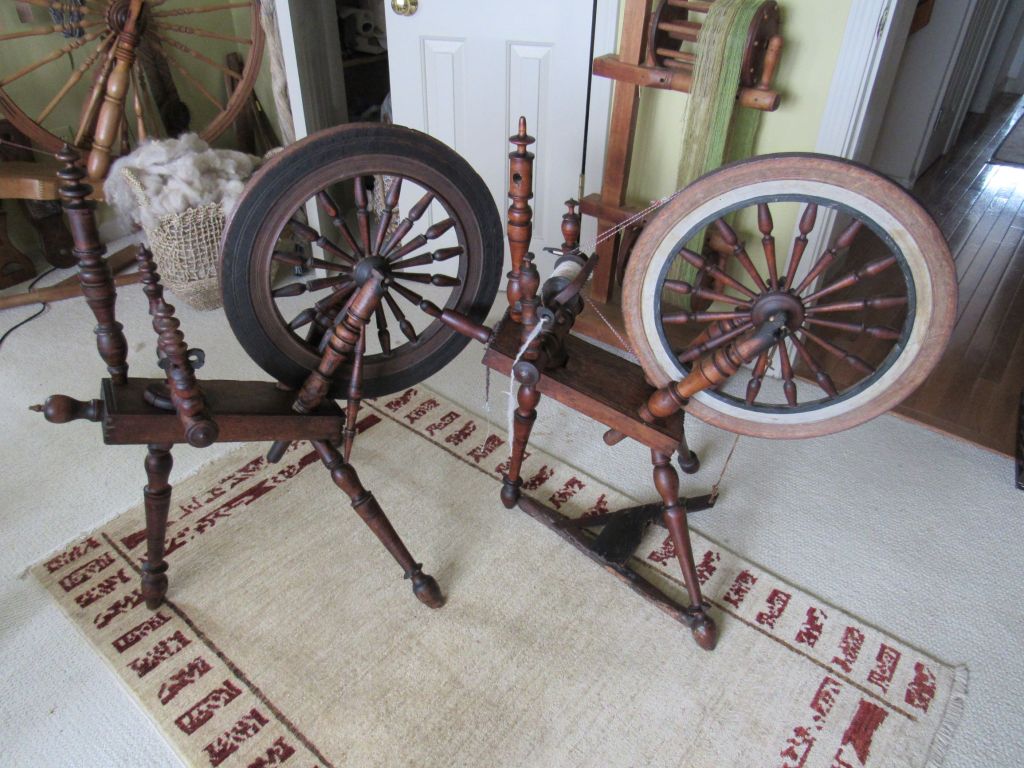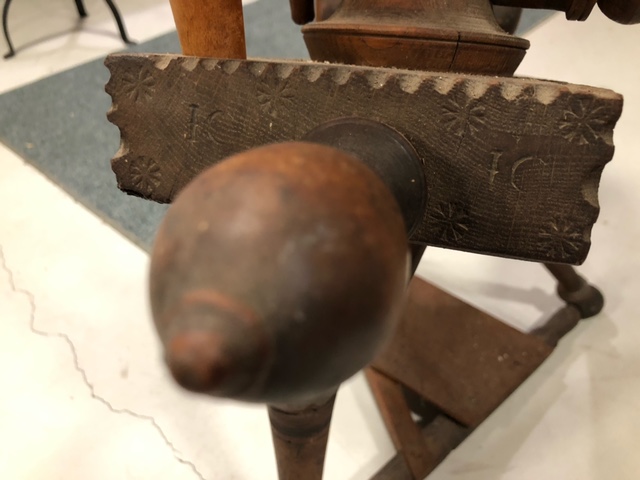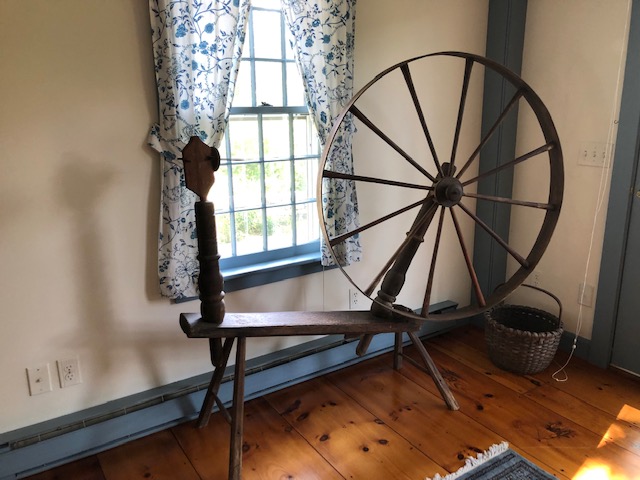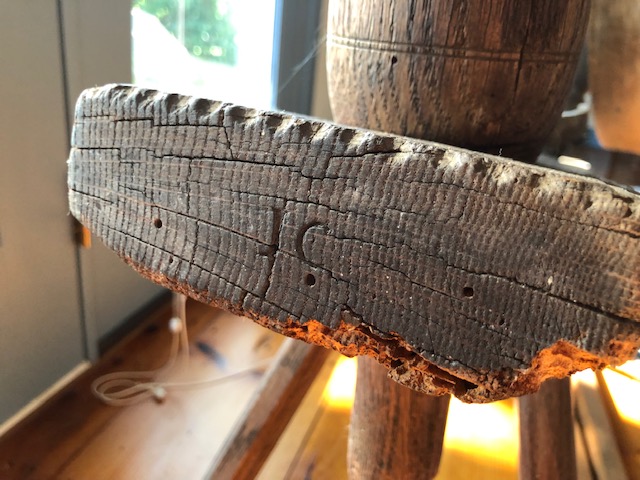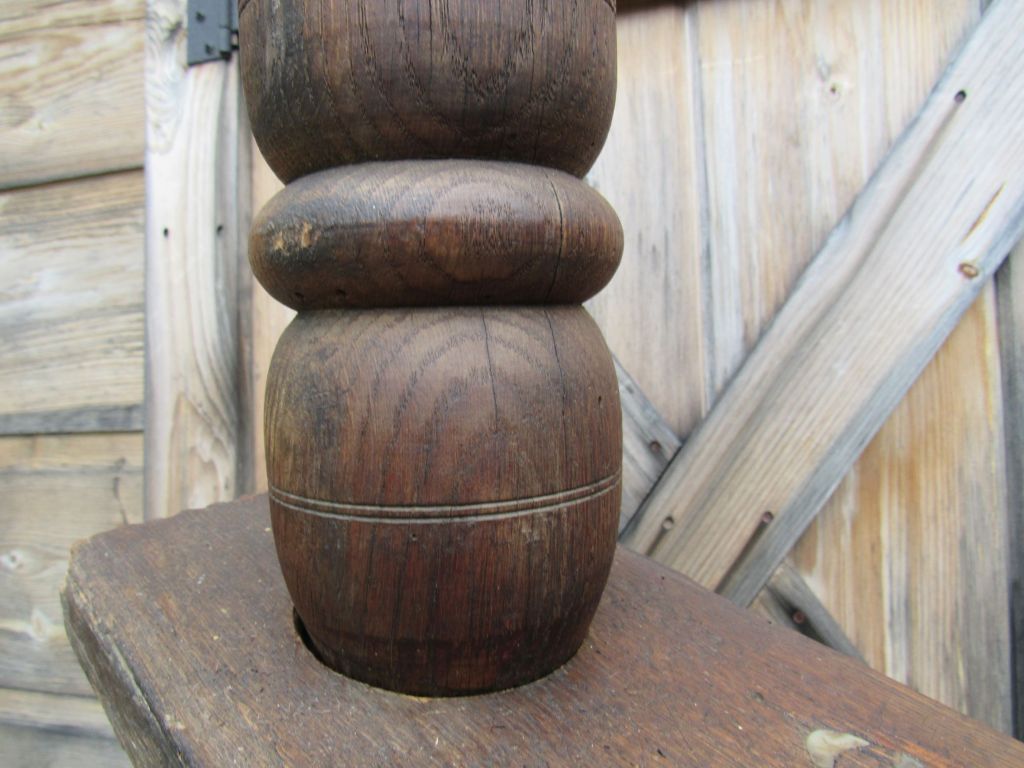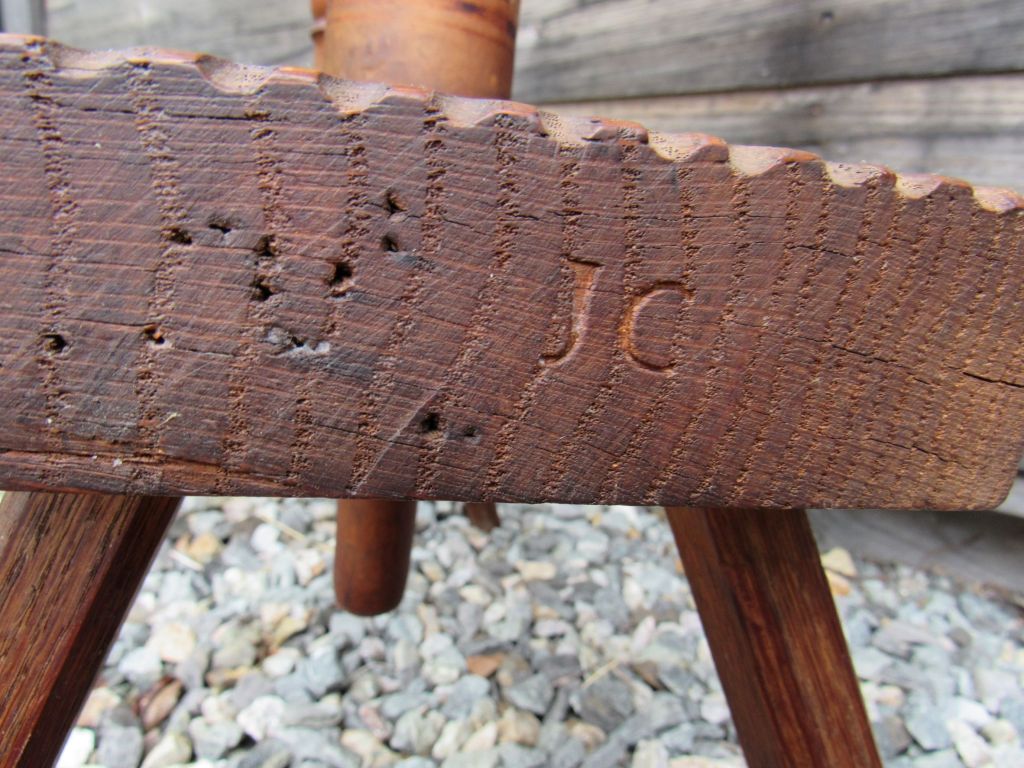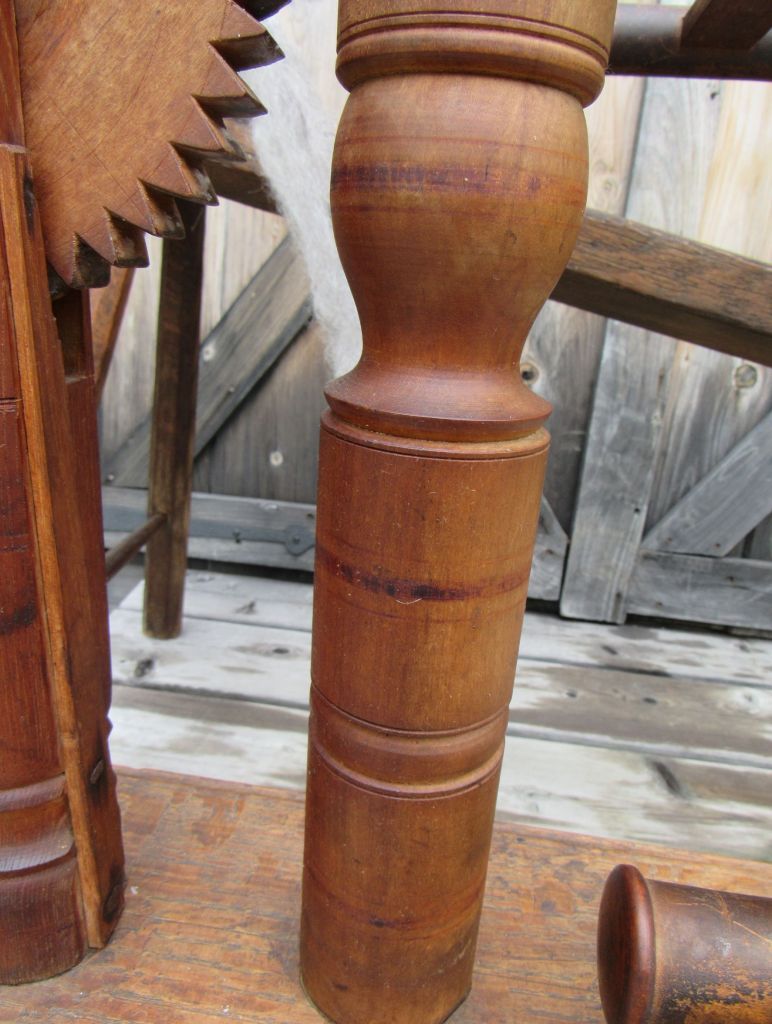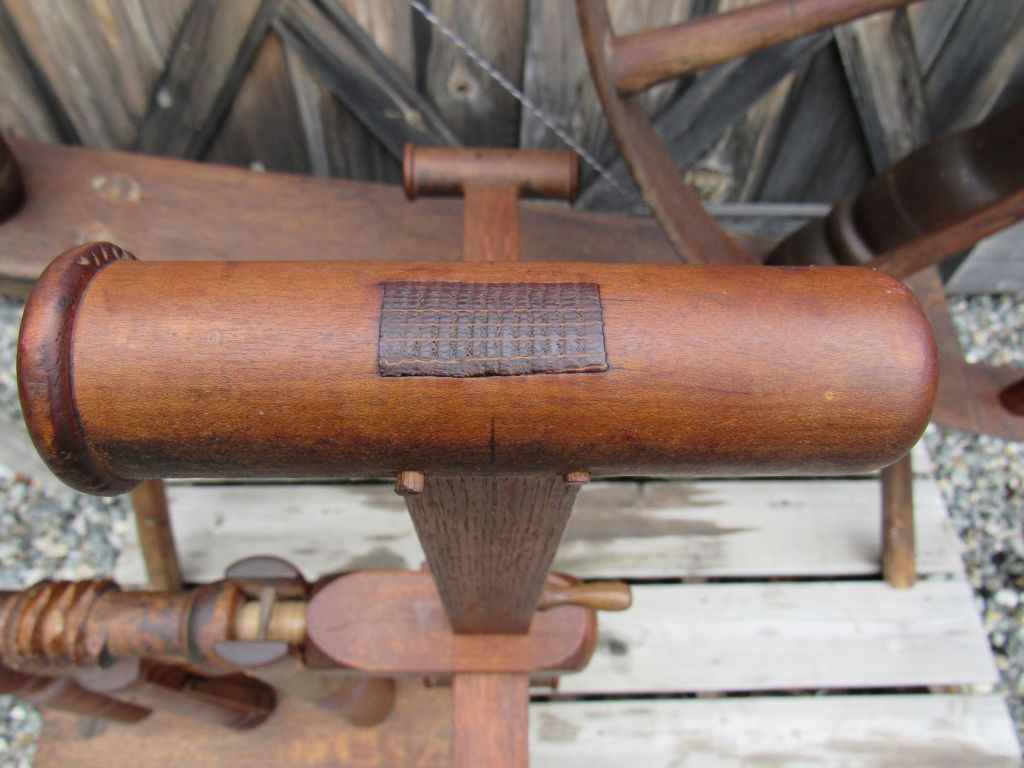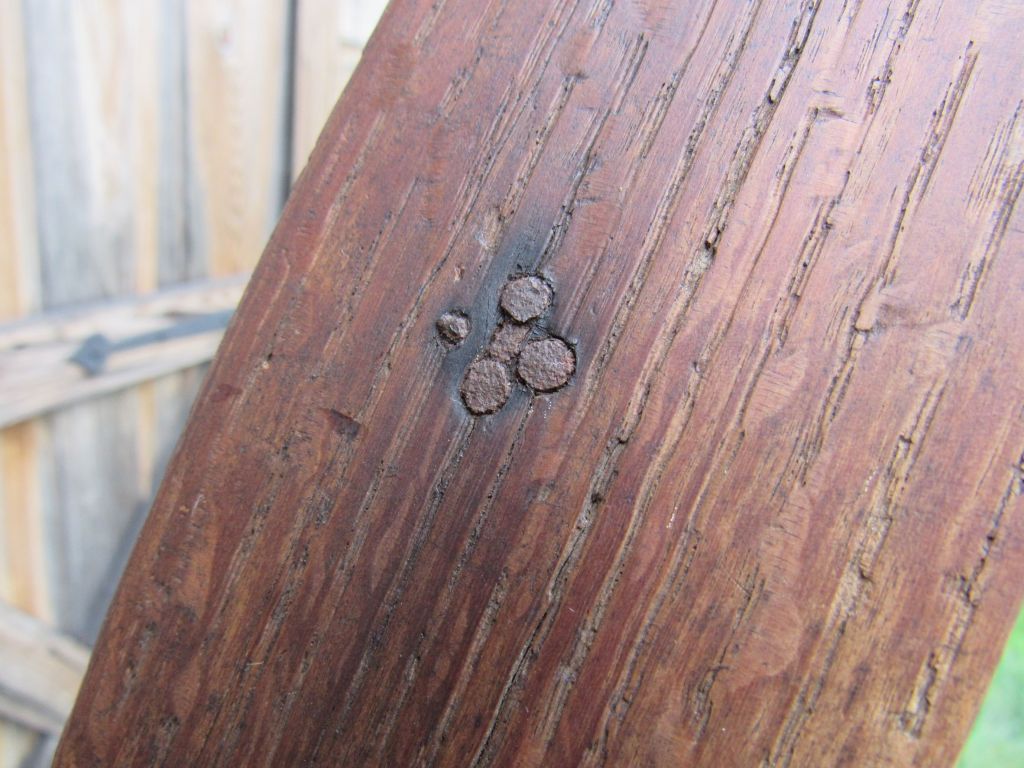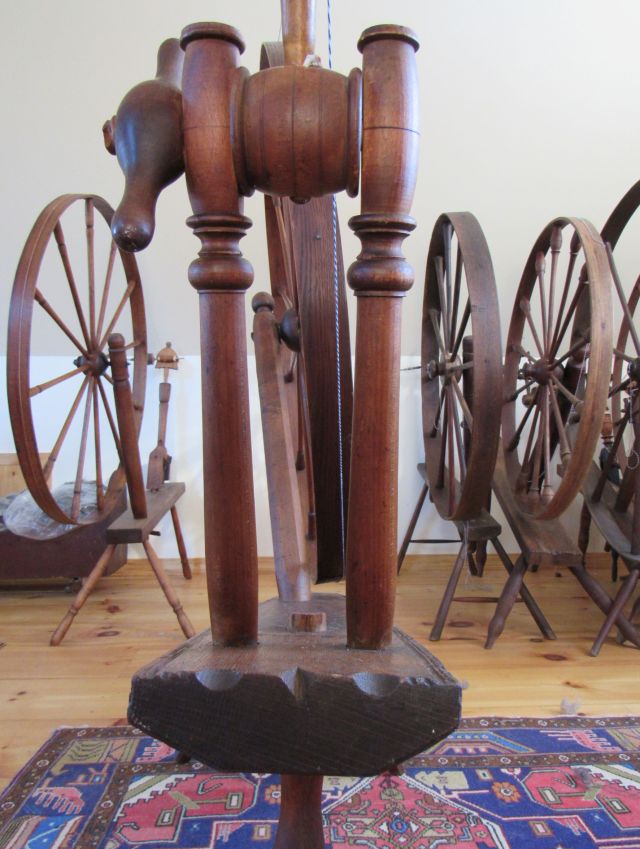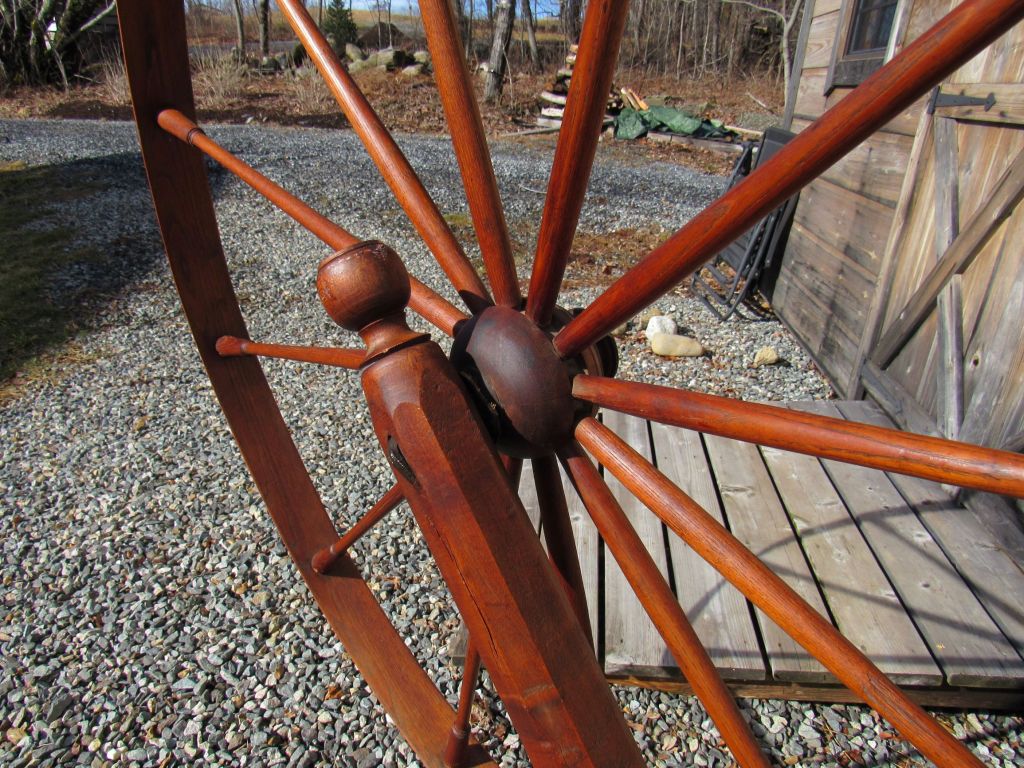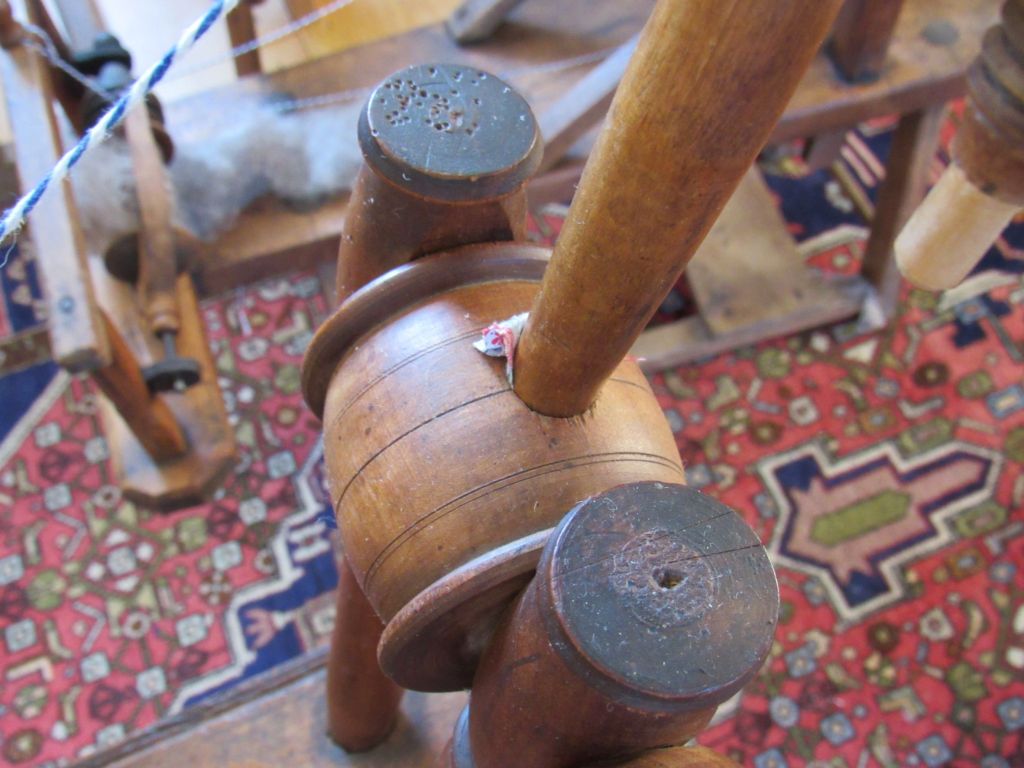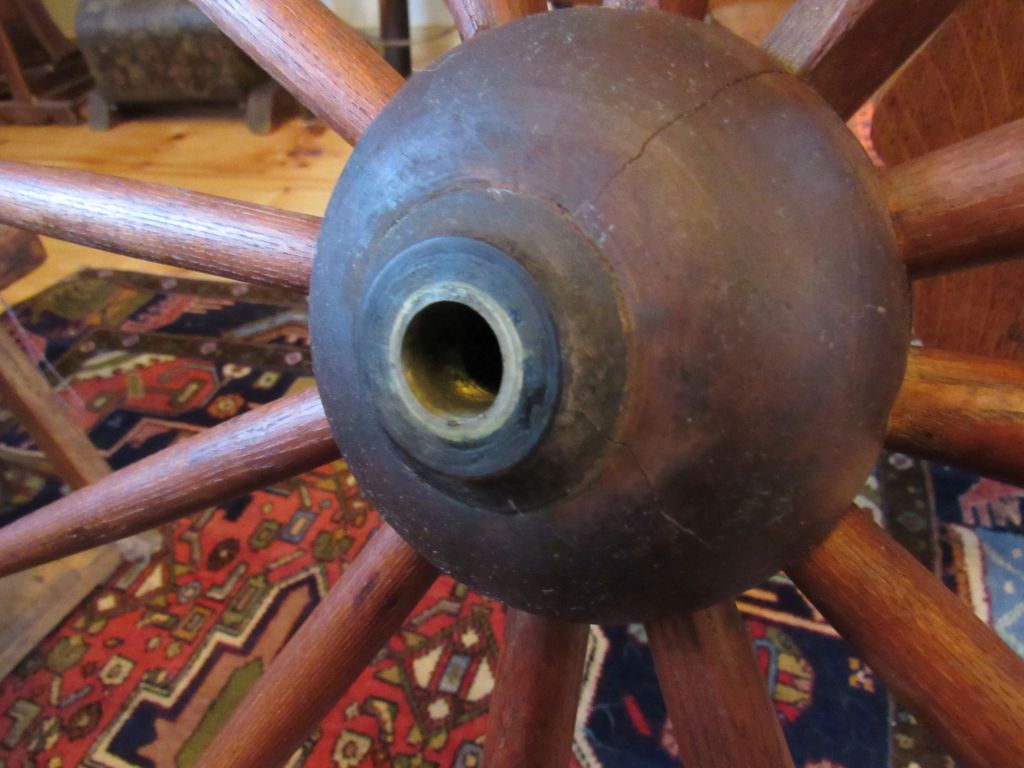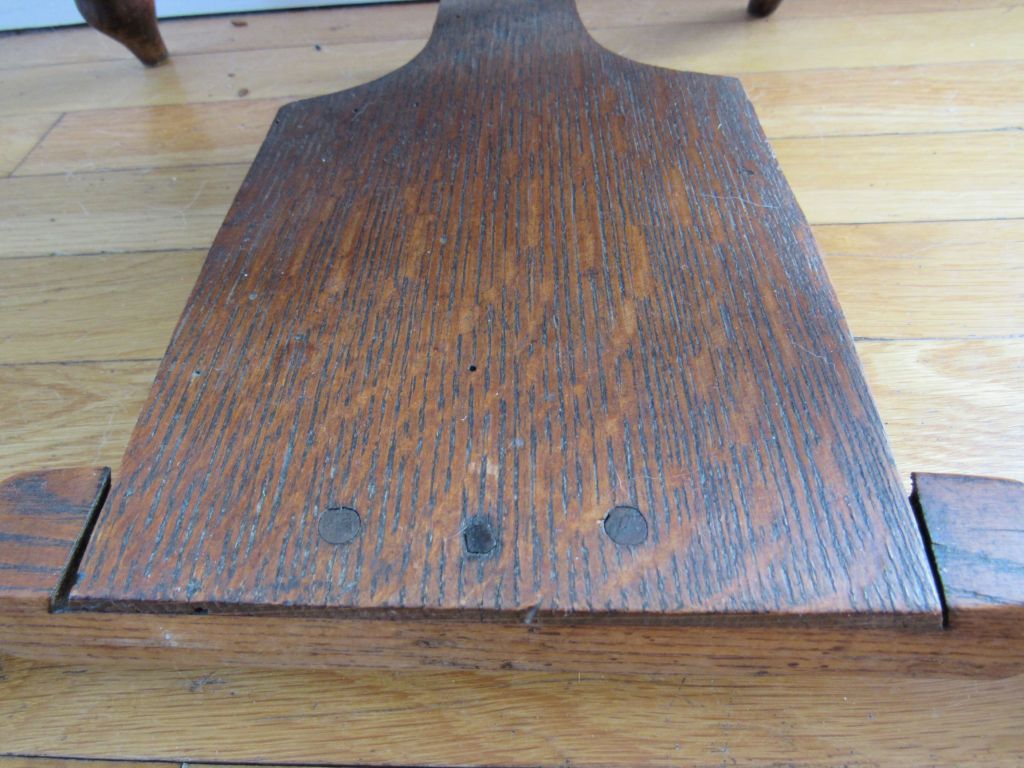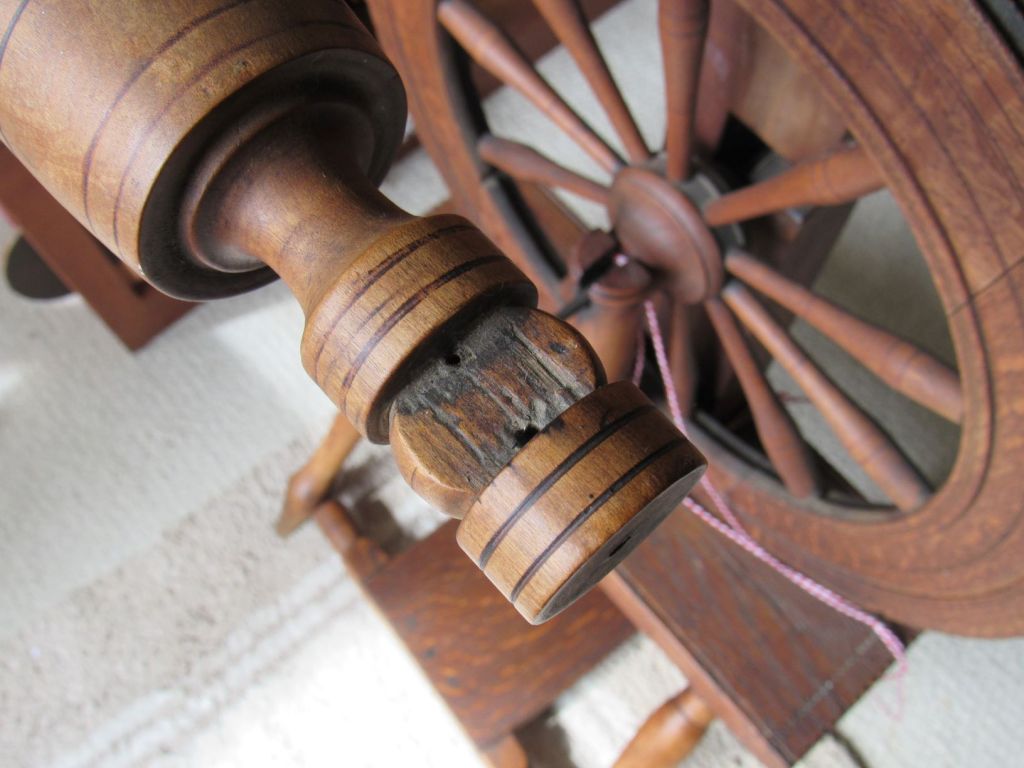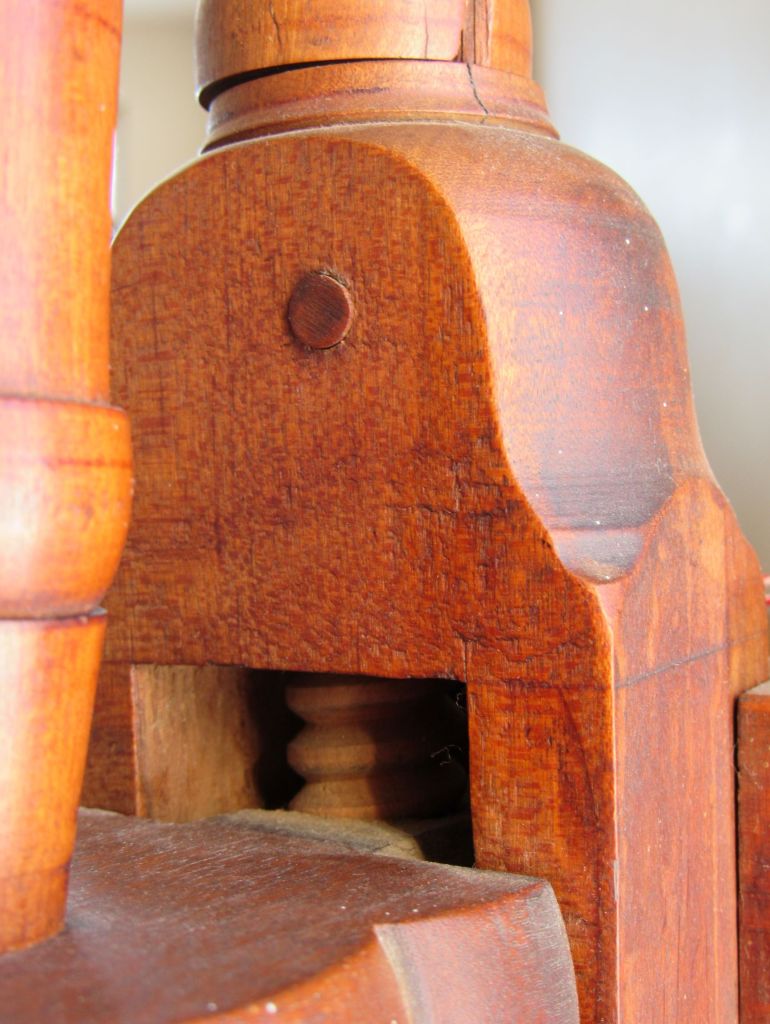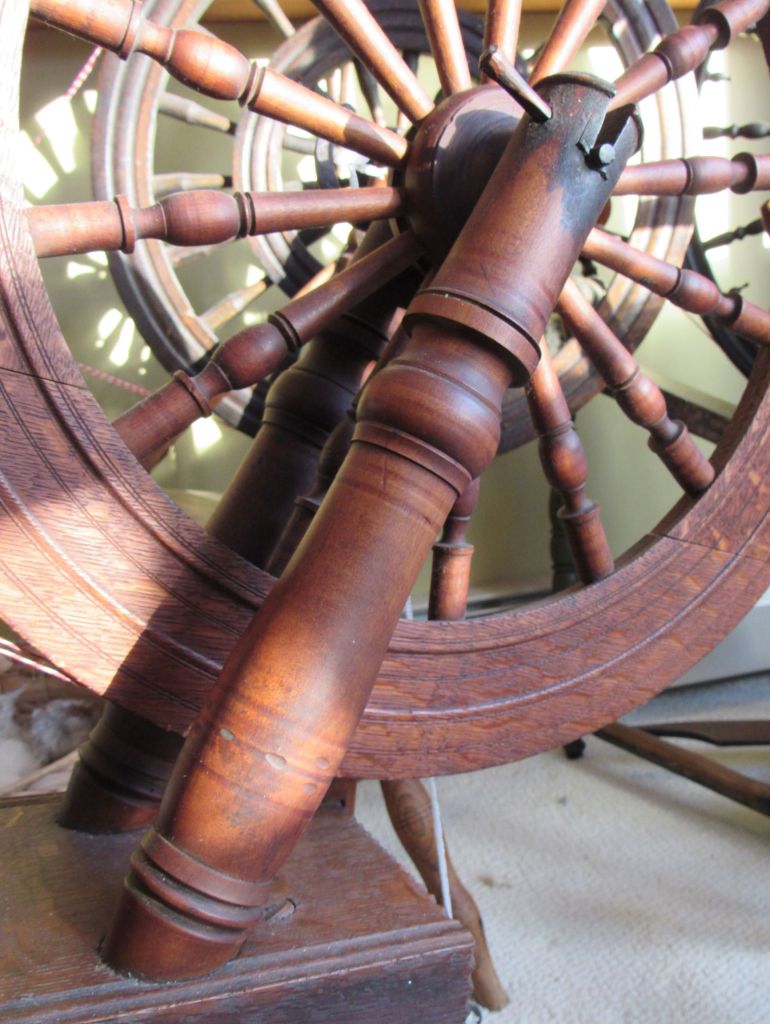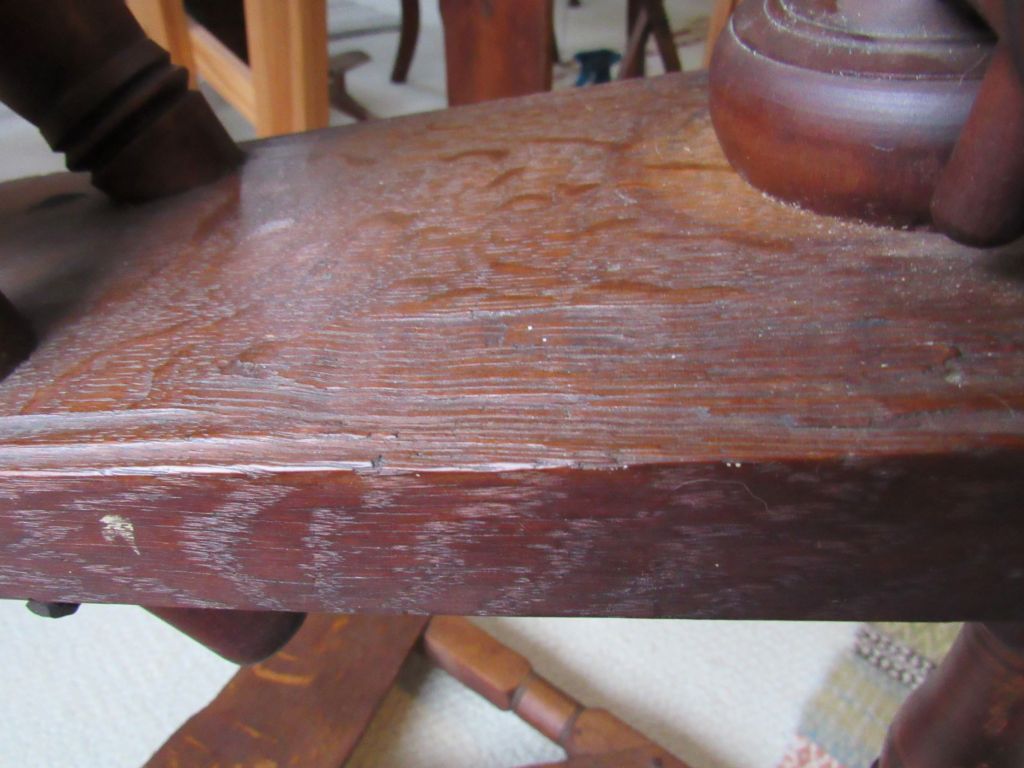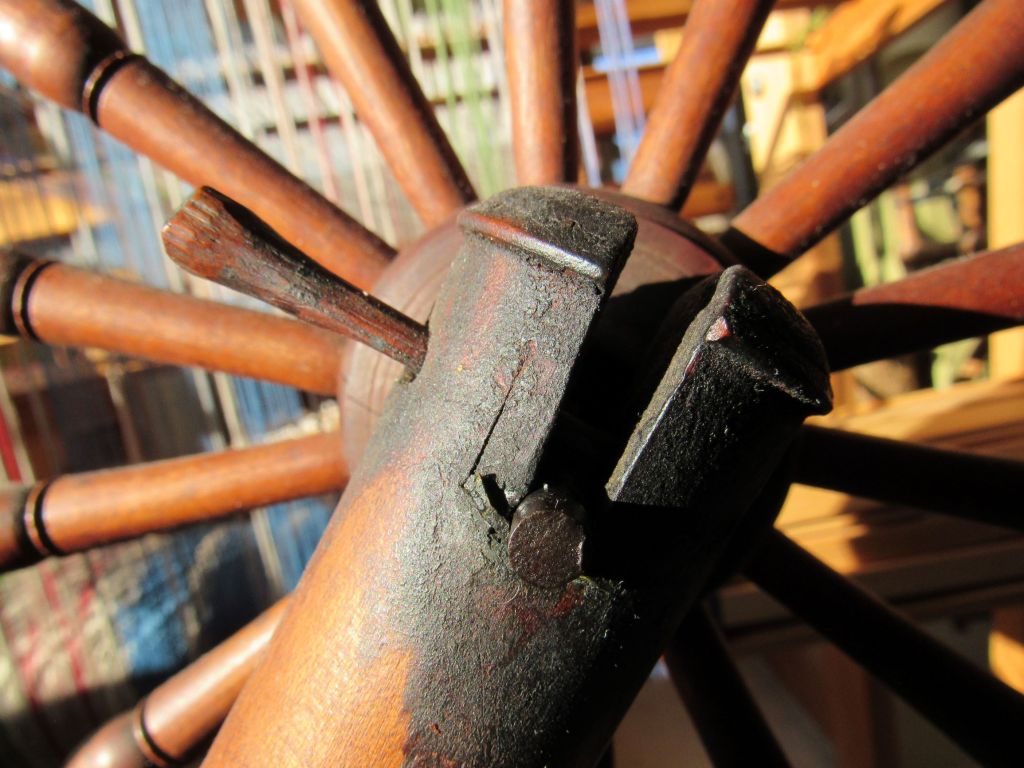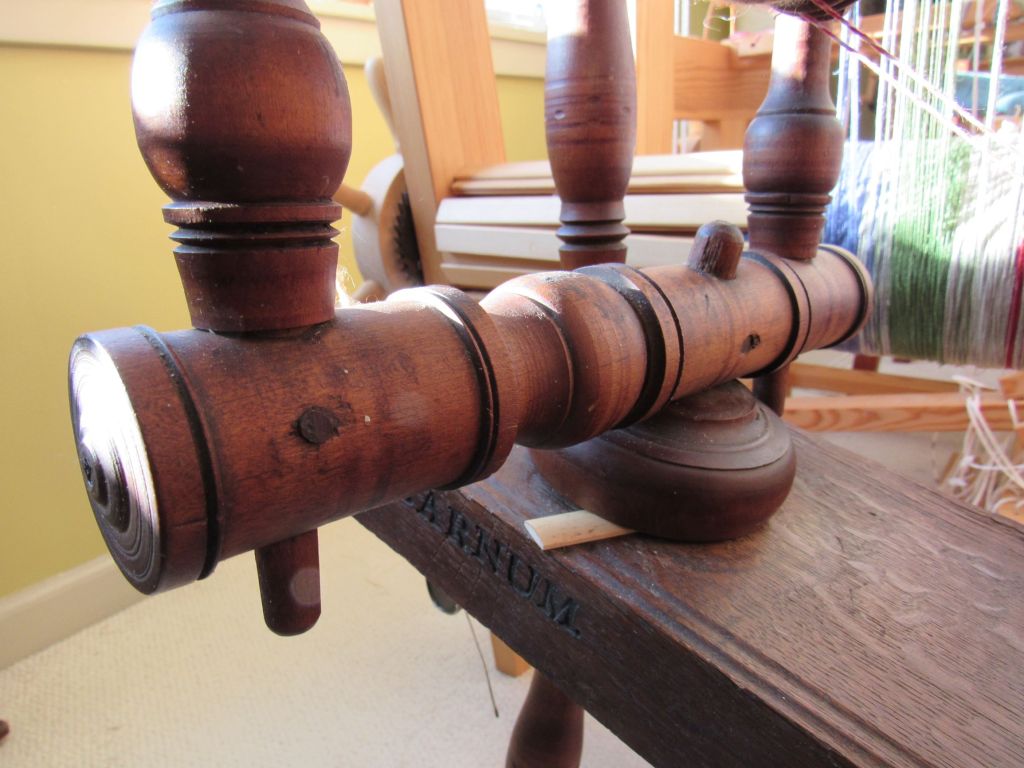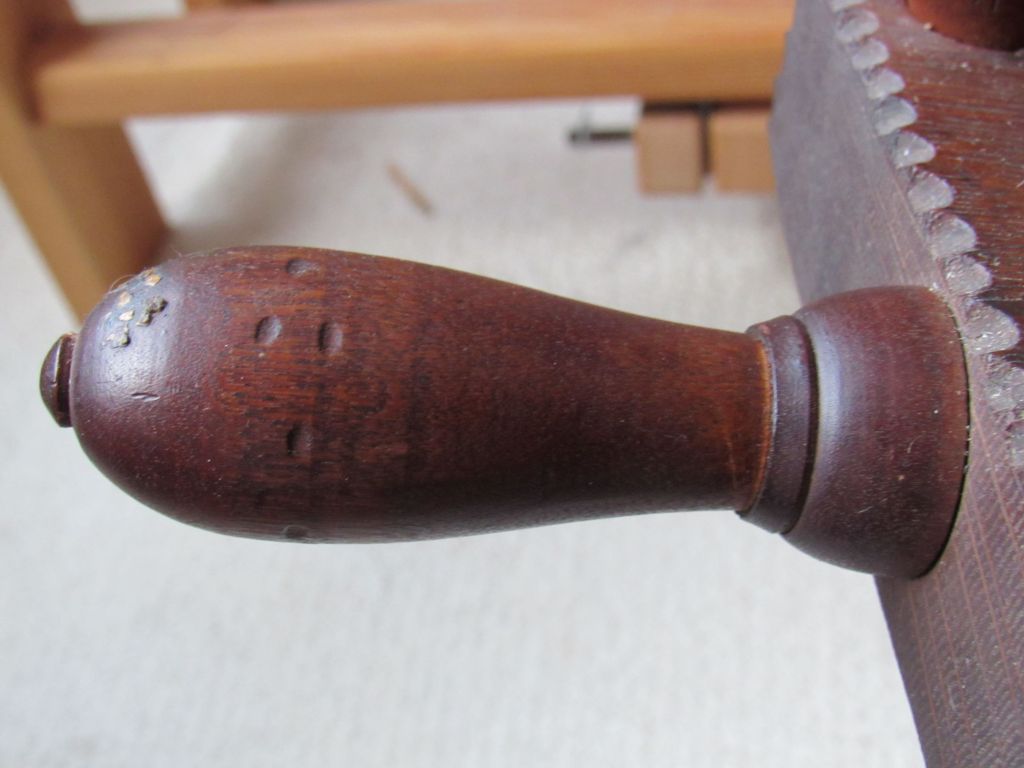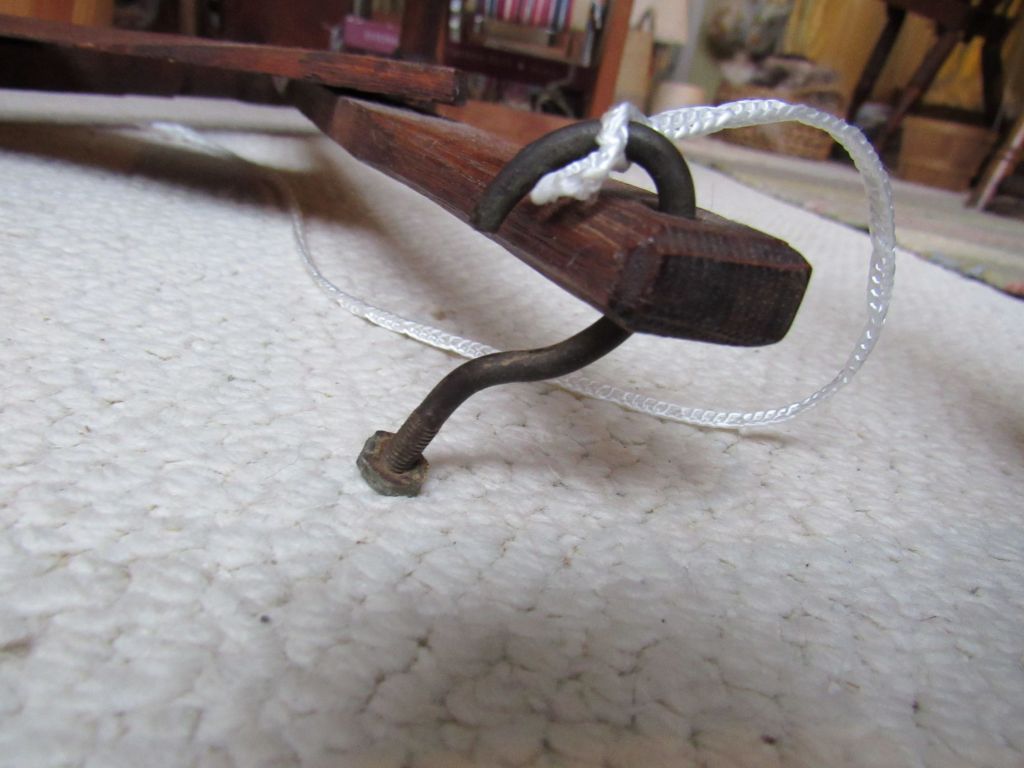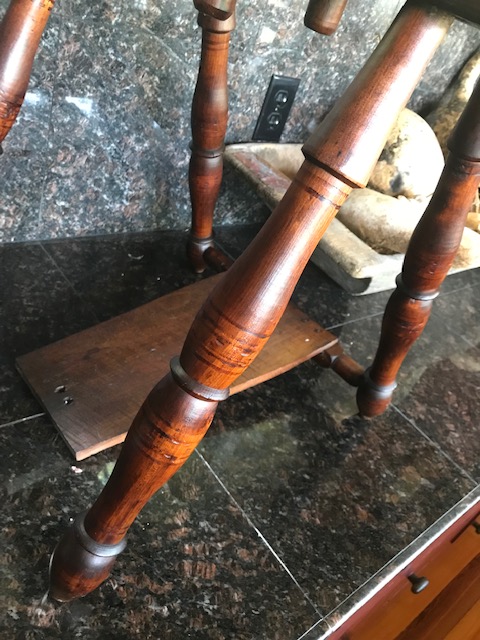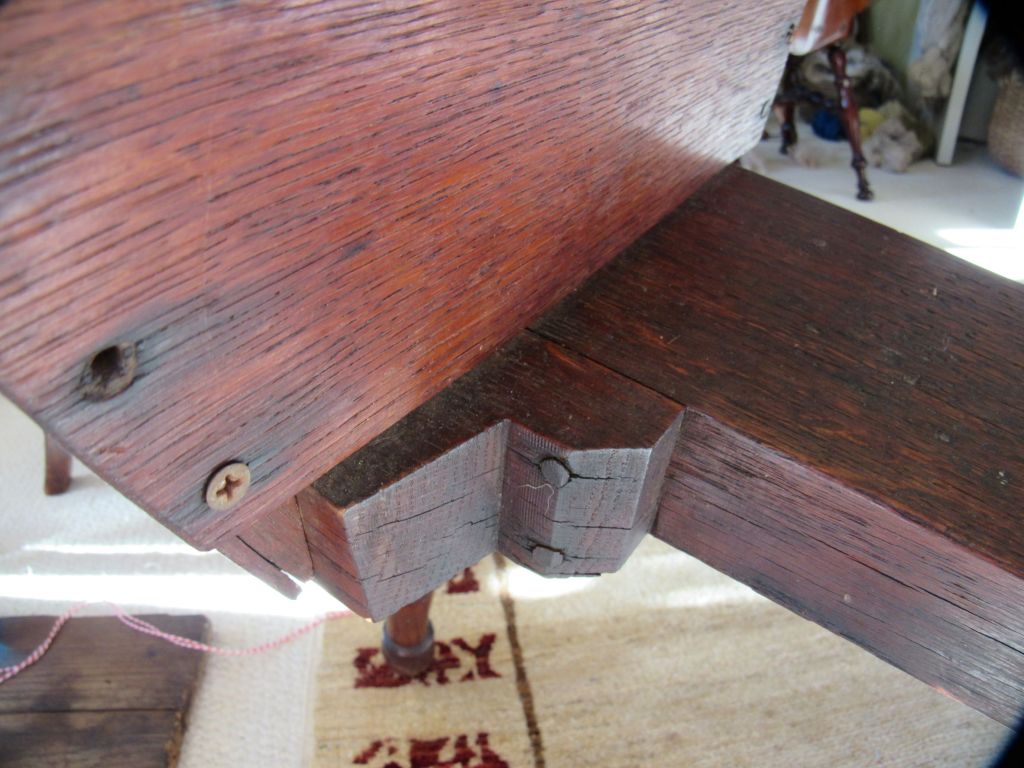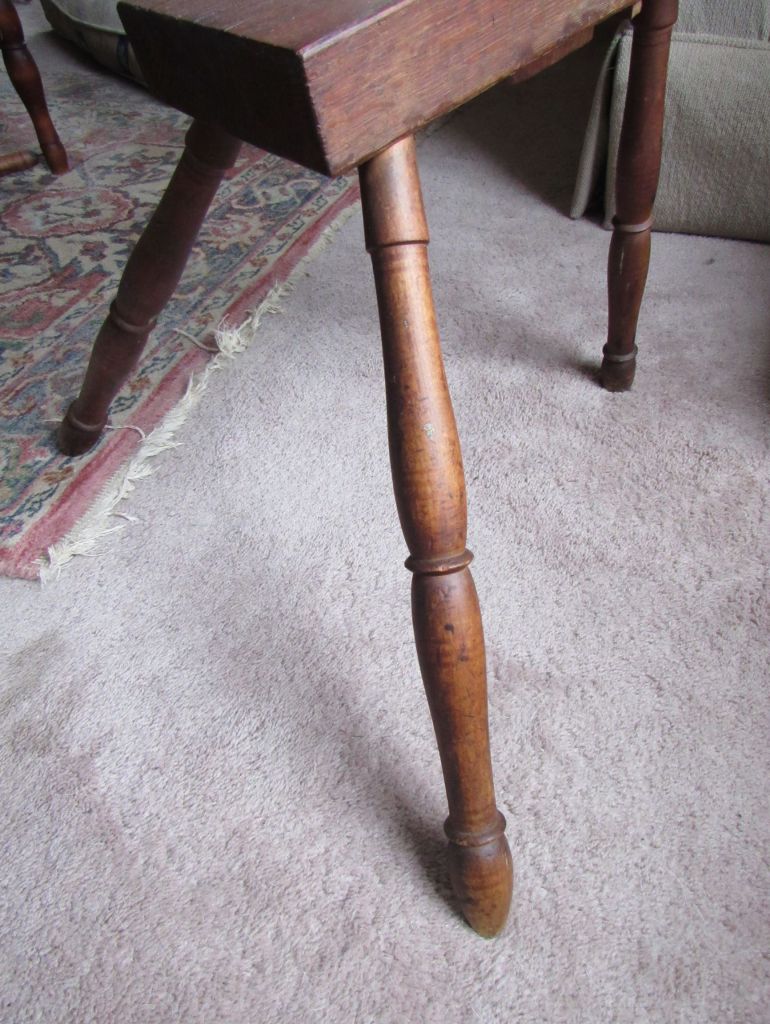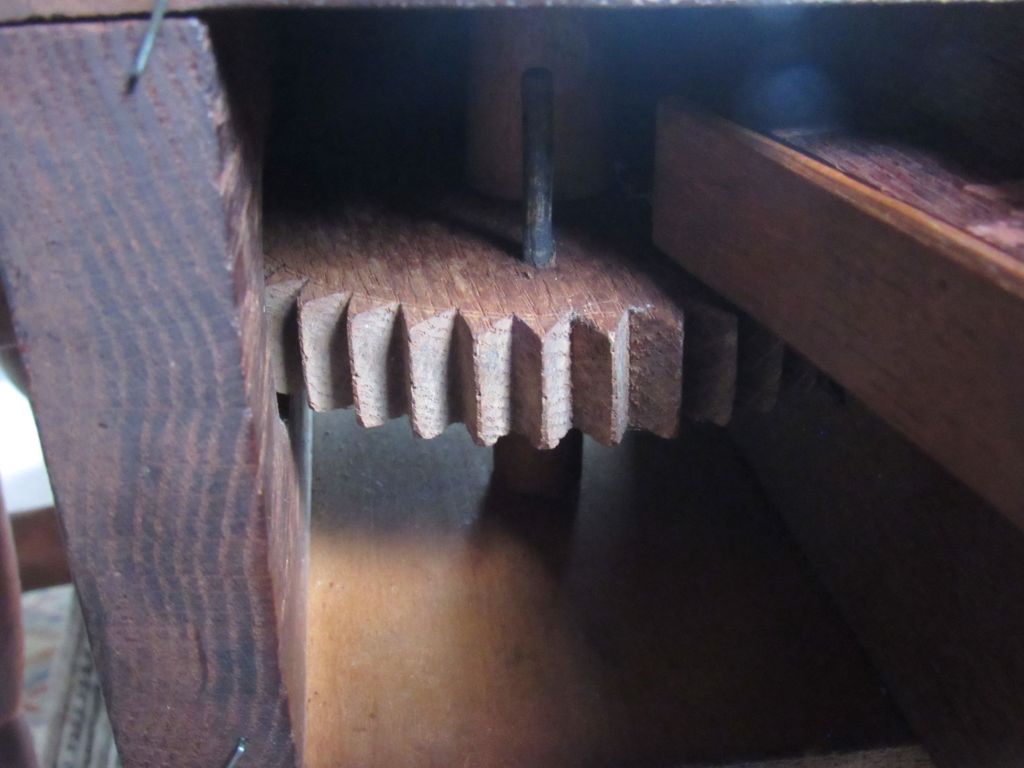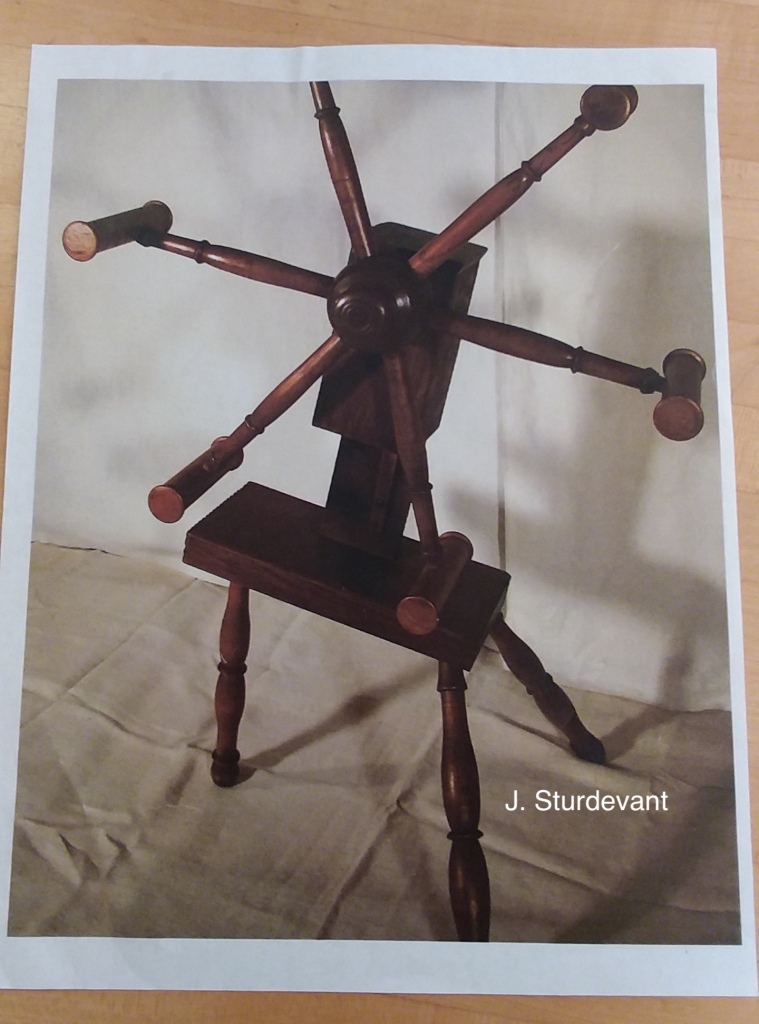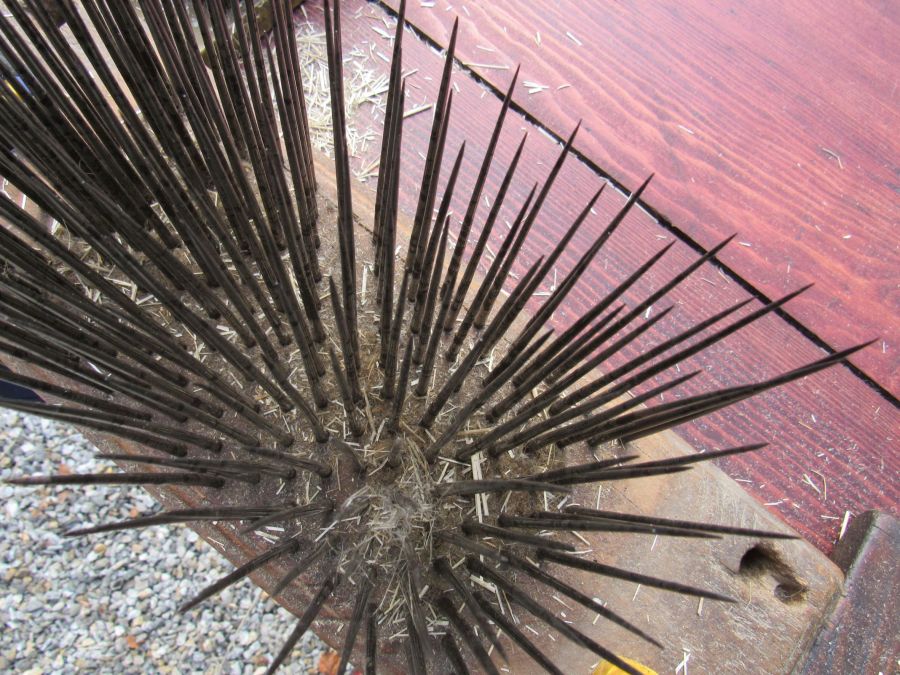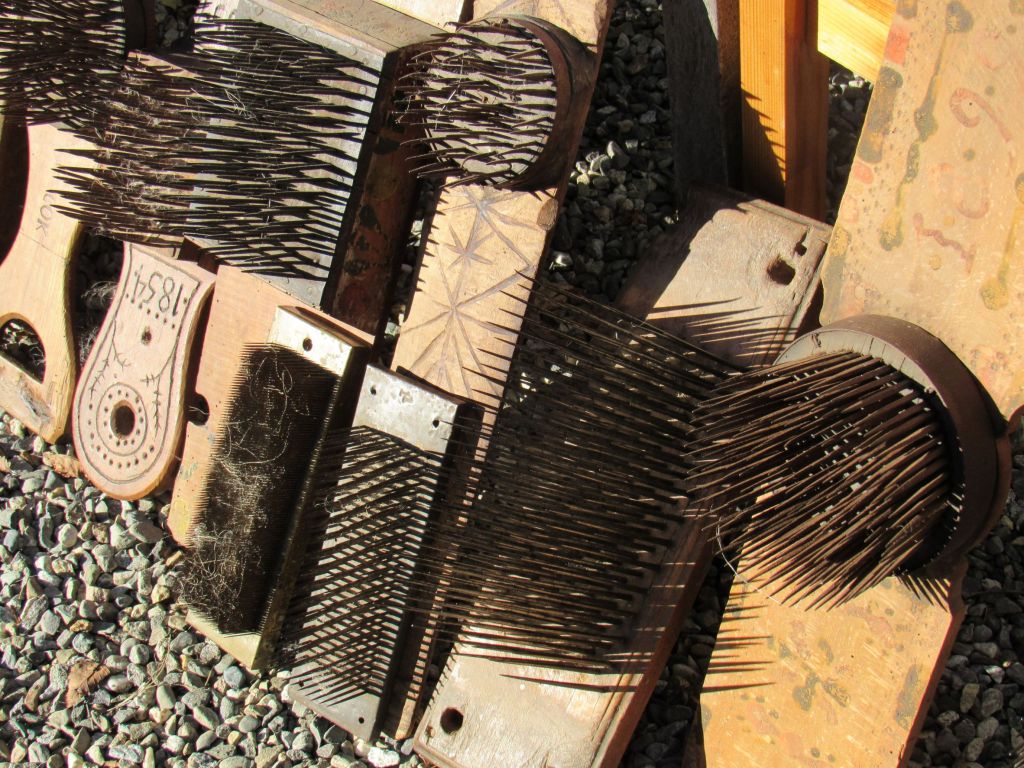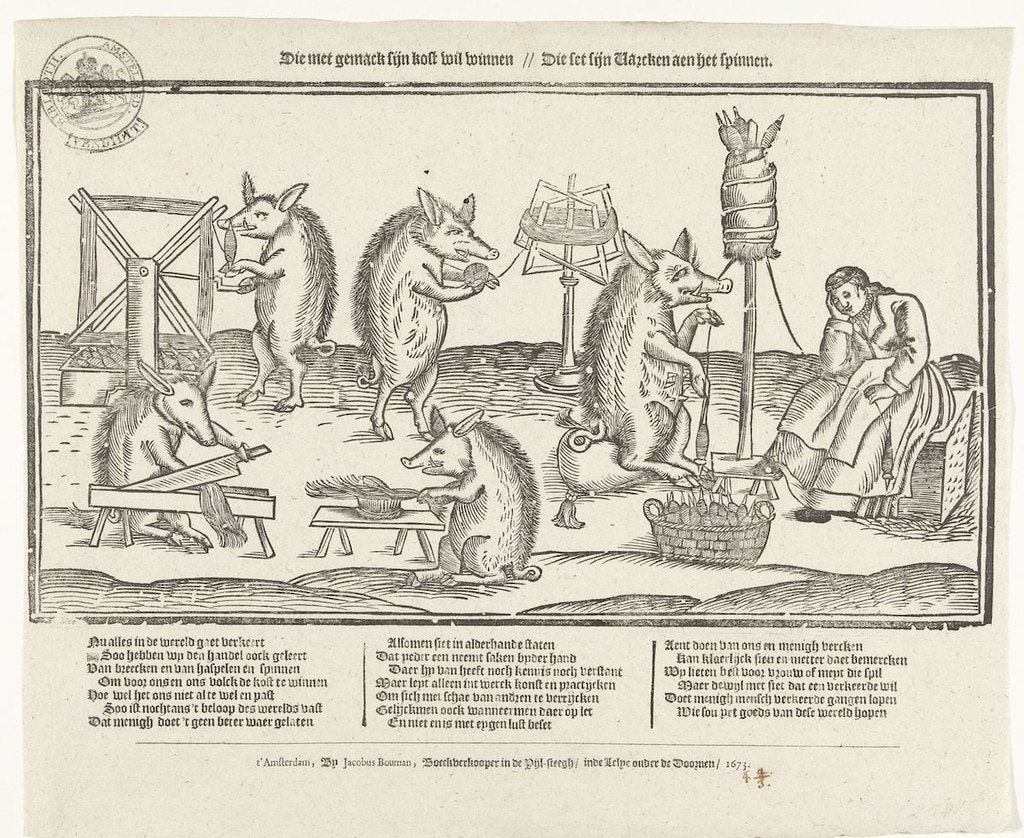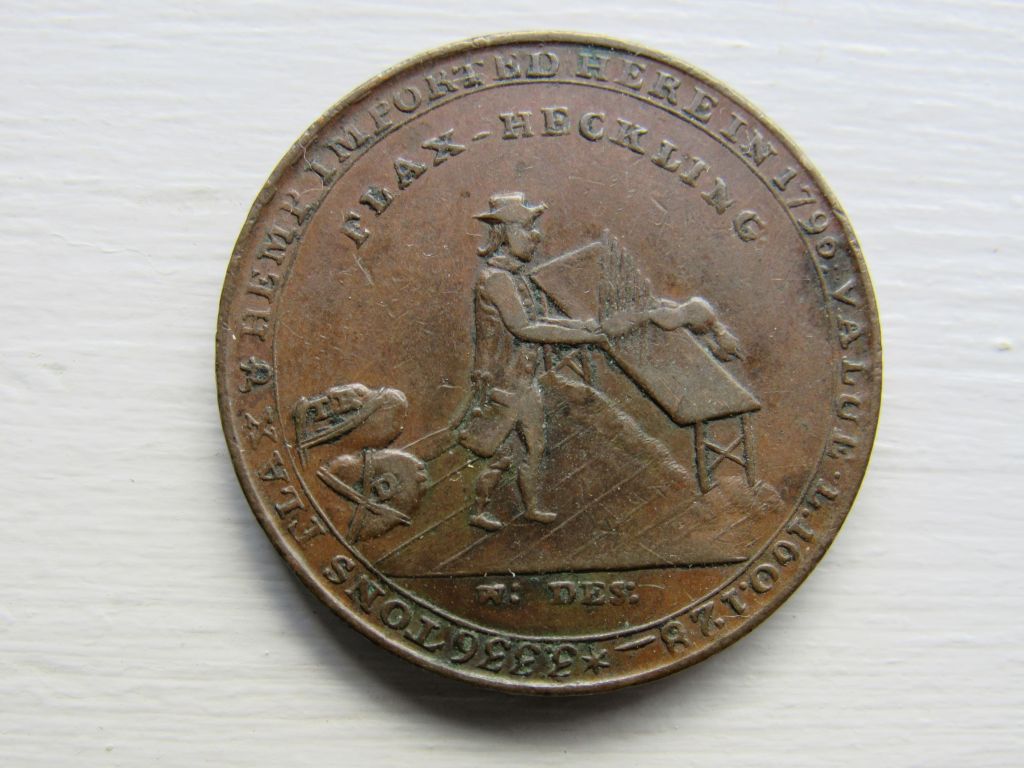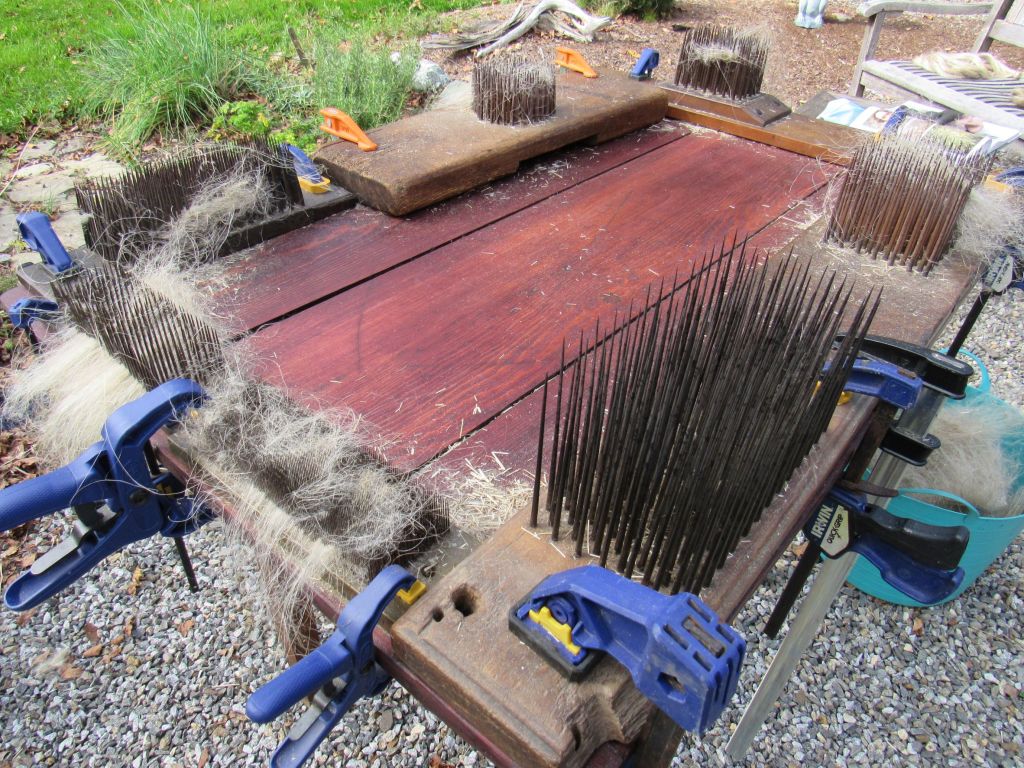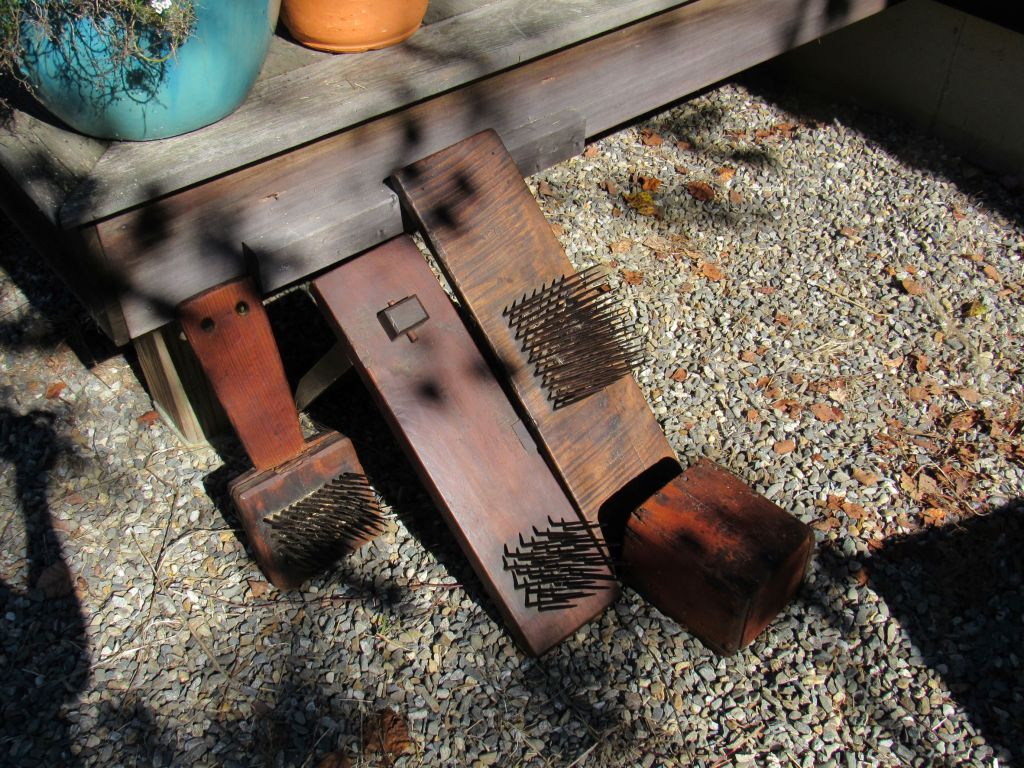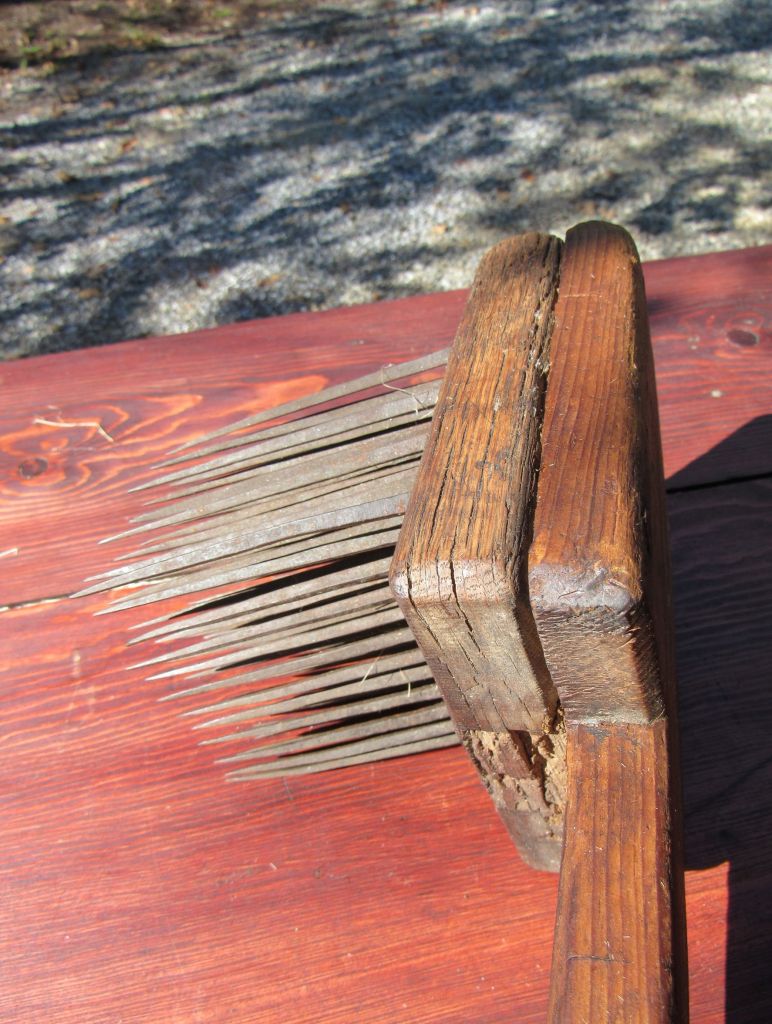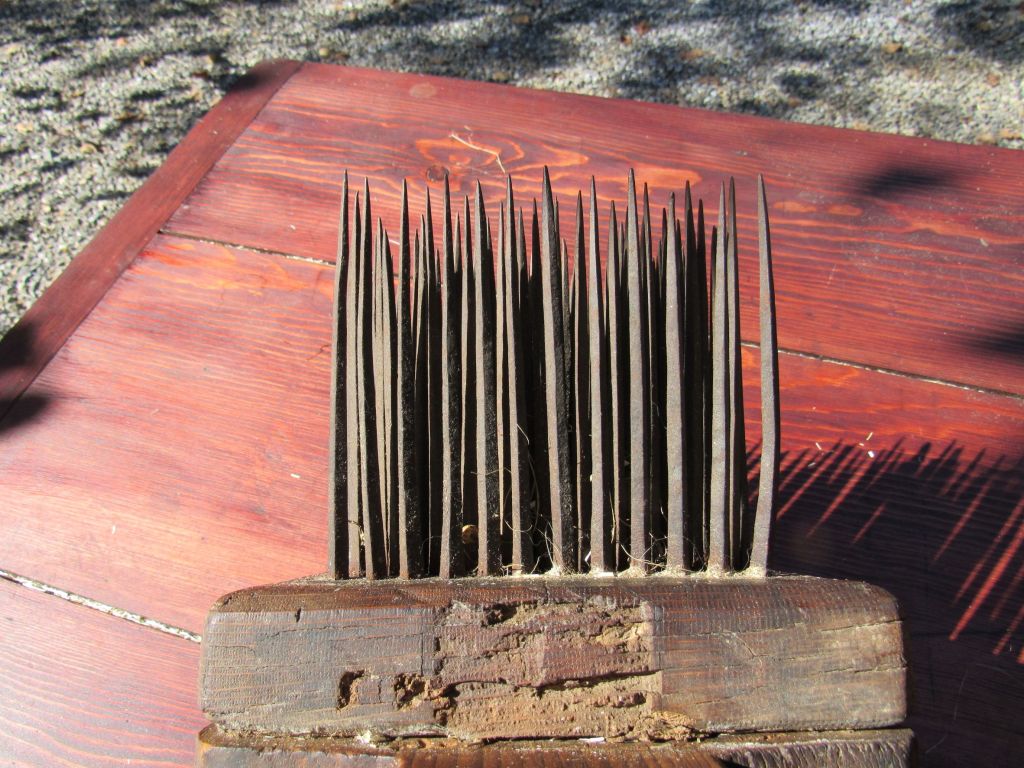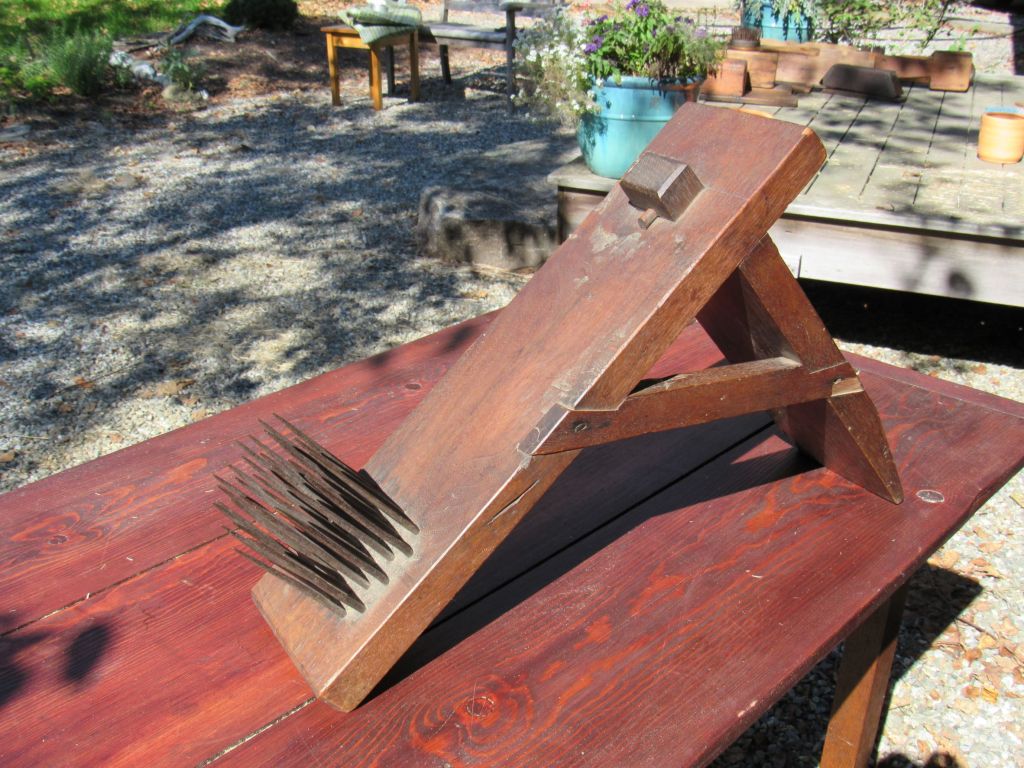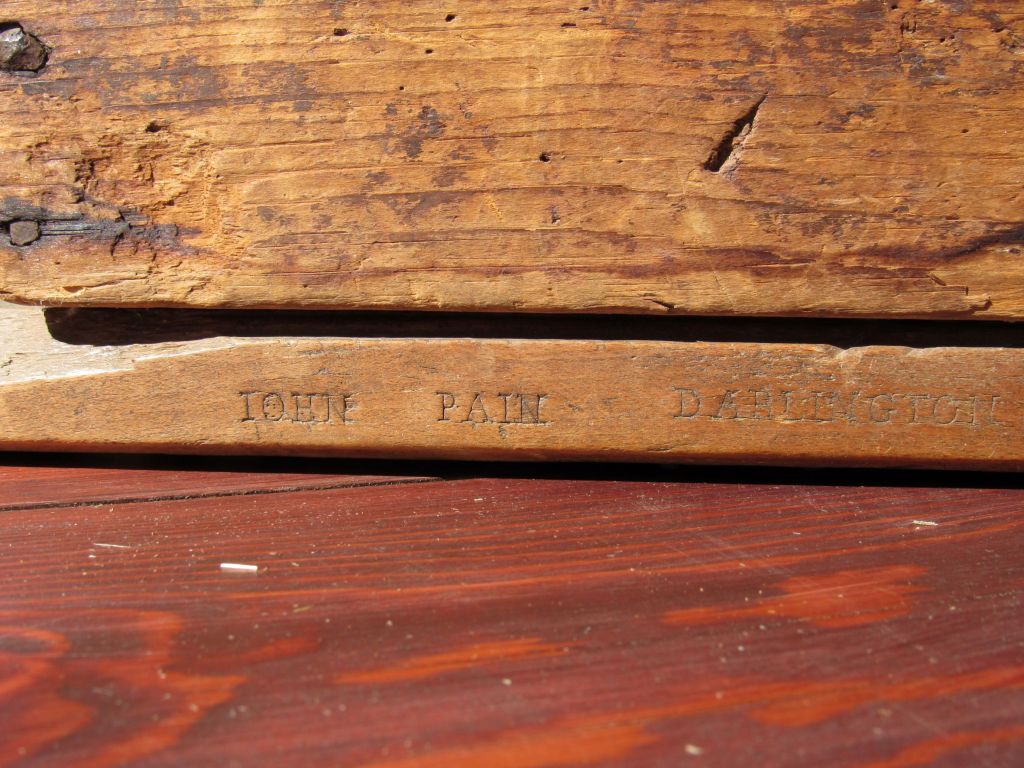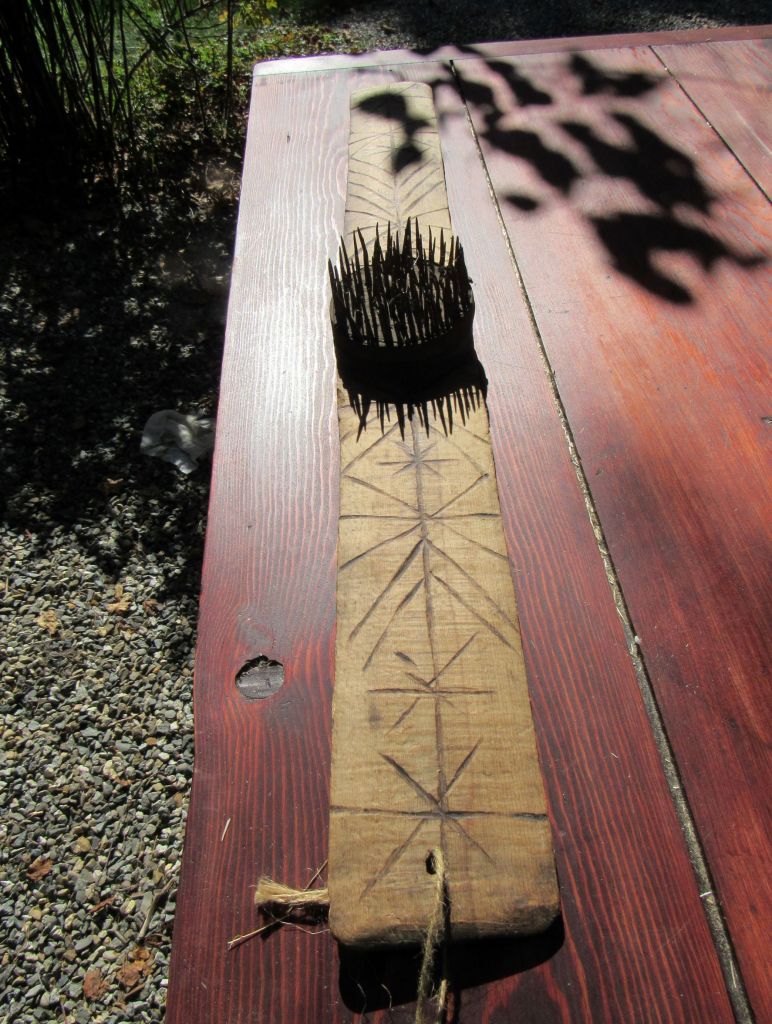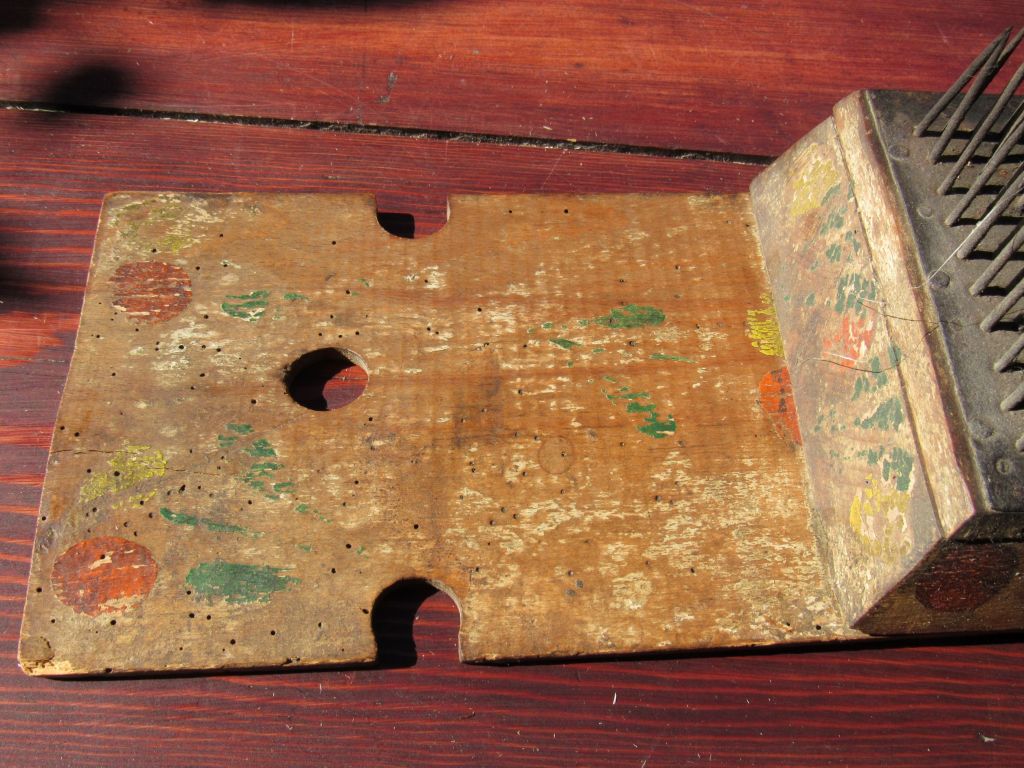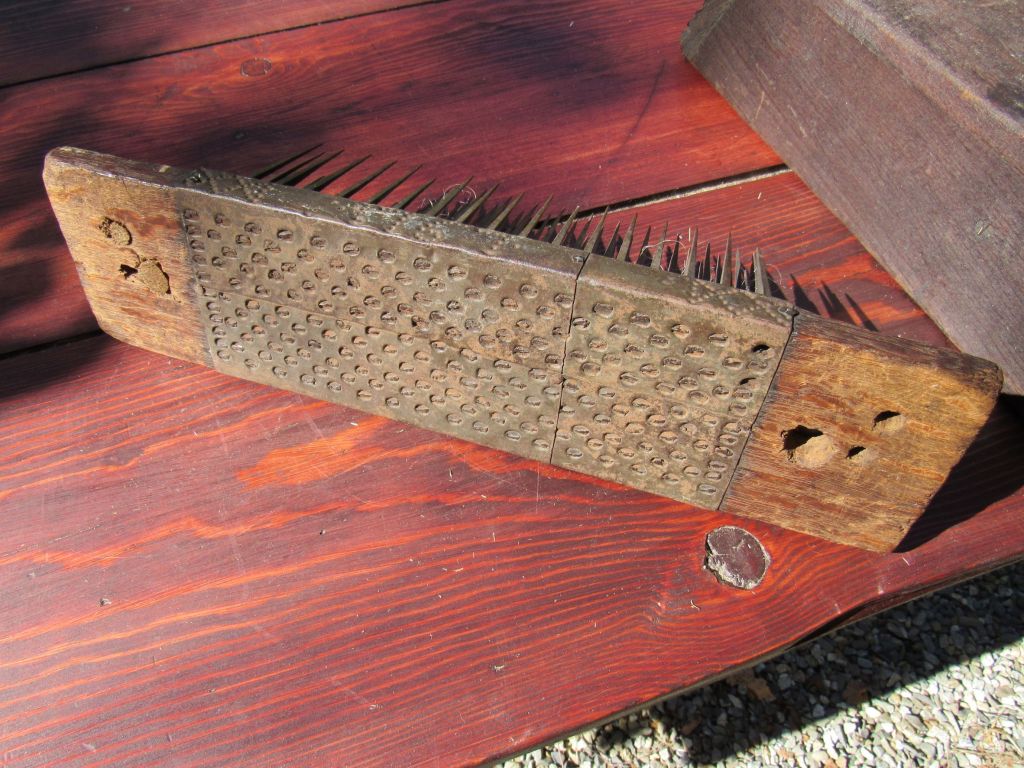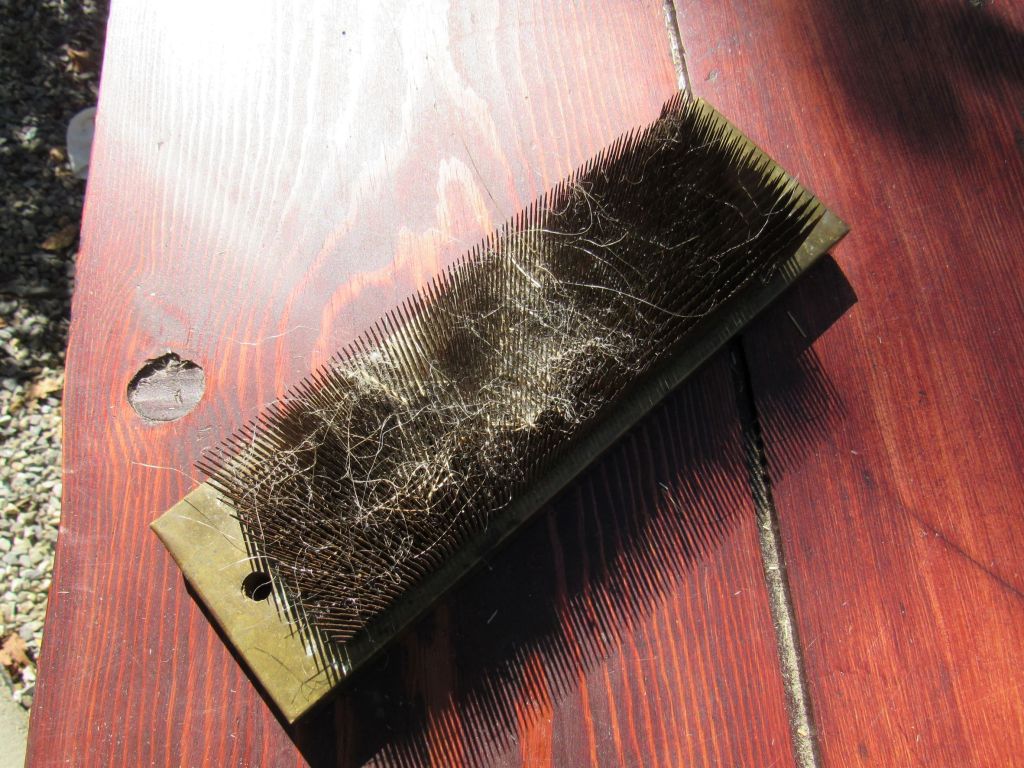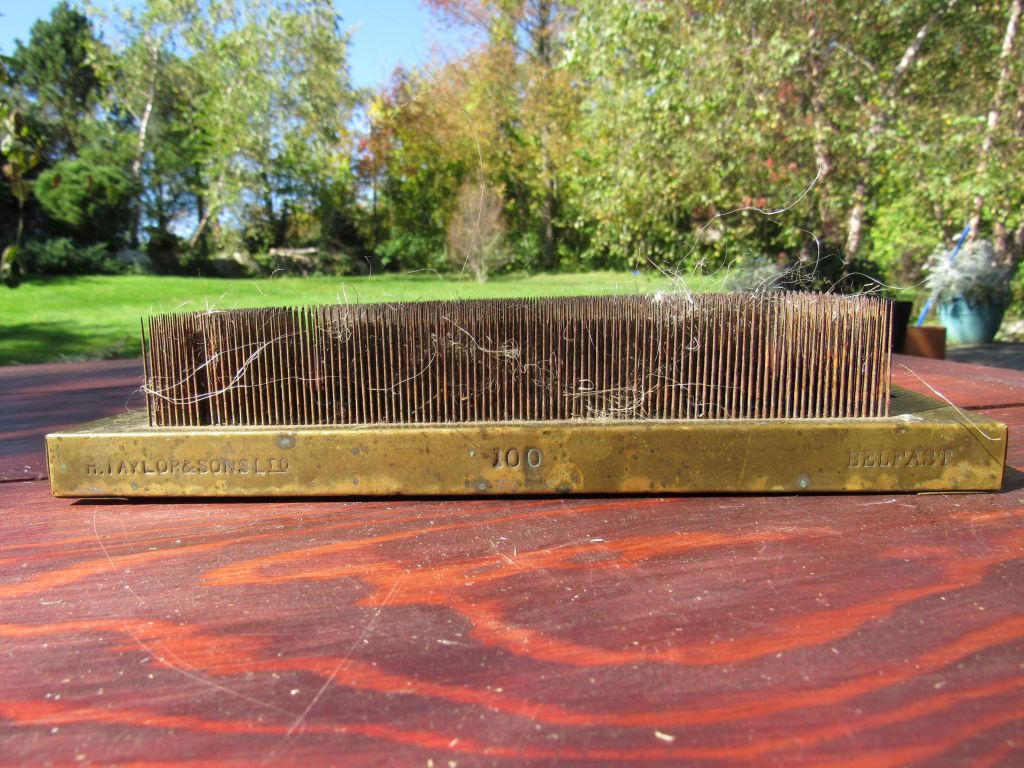
There are different types of challenges in determining who made specific antique wheels. Some wheels, such as Woody Hill in the previous post, have a maker’s mark, but we cannot track down the maker. Others, such as Scarlet, appear to be from a known maker, but have no maker’s mark.

Only a handful of wheels have surfaced in the antique wheel world that look like Scarlet. Of those, most have the maker’s mark, “P Wood,” stamped on the table’s end grain.

Try as I might to find remnants of a mark, it looks as if Scarlet’s end grain bears only paint.

Yet this striking wheel, highly decorated and finely turned, shares so many characteristics with the marked wheels, it is reasonable to presume that she was made by the same wheel maker, Phineas Wood (1767-1847), of Dover, Vermont.

Thanks to several researchers, we know something about Wood’s life. Quite a few of his great wheels, both marked and unmarked, are still around. In an article in Issue 90 of the Spinning Wheel Sleuth, Susan Hector traced her journey researching her P Wood great wheel. (“Identifying a Phineas Wood Great Wheel,” pp. 4-5). She confirmed that the “P Wood” mark belonged to Dover’s wheel maker, Phineas Wood.

Dover–in southeast Vermont, north of Wilmington and west of Newfane–is best known these days as home to ski area, Mount Snow. An early history noted that “the surface of the town is exceeding uneven, and a view from some of its highest hills present to the eye scenes both picturesque and grand,” with streams “which afford several small mill privileges,” and soil that “is hard of cultivation, yet some good crops are produced thereon, and the hillsides afford excellent grazing.” (Vermont Historical Gazetteer, “Dover” pp. 337-356).

Phineas came to Vermont from Massachusetts, where he was born in Mendon in 1767, the son of Solomon Wood (who died in Uxbridge in 1820). Phineas’ younger brother, Obadiah Wood, born in 1773, also made spinning wheels and chairs. “After the establishing of factories along the streams and the use of power in making furniture, [Obadiah] went to work for various shops in the wood working business. It is claimed that he was the first bobbin maker in this country. His business grew to extensive proportions, and he had orders from the South American countries and other distant points. He established a large and prosperous industry in making bobbins.” (Historic Homes and Institutions of Worcester County, p. 67). Obadiah “was largely a self-educated man, well read, and holding well-considered but firm opinions on matters of public policy. He was a skillful mechanic and sagacious business man” and a member of the Society of Friends. Id.

Phineas, like Obadiah, appears to have been a skillful mechanic, with an inclination toward business. Phineas was married in Mendon in 1791, to Chloe Hazeltine. Chloe’s father moved to Wardsboro, Vermont (near Dover) around 1795 and Phineas shows up in Vermont on the 1800 census. So he likely moved to Dover, or nearby, between 1791 and 1800. In about 1820, when he was in his 50s, Phineas set up a carding machine in the “Goose City” part of Dover, raised geese, and established a goose-down factory where ten “female employees plucked geese and made their feathers into down-filled mattresses and pillow.” (Historical Gazetteer, “Manufacturers;” SWS, Issue #90, p. 5, citing Deerfield Valley News article)

Phineas Wood’s great wheels are known for their fine workmanship and attention to detail, although the details often differ from wheel to wheel. Some, such as Susan’s, have flat-topped double upright spindle supports. Many of his great wheels, however, have unusual round-topped double upright supports, such as the one pictured below and another described in Grace Hatton’s blog here: http://antique-spinning-wheels.blogspot.com/2011/06/p-wood-great-wheel.html.

While there are quite a few examples of Wood’s great wheels, very few of his flax wheels have come to light. The following four photos are of a marked P Wood flax wheel for sale a few years ago, which were posted on Ravelry.



Perhaps the best example, though, is one that turned up in the Midwest–a marked wheel in even more pristine condition than Scarlet. It is through this wheel’s owner, Julie, that I learned on Ravelry about Phineas Wood and his wheels.


As these wheels show, Phineas Wood approached his flax wheels with creativity and an emphasis on beauty. They must have been time-consuming to make. Presumably their price reflected all that work, which makes me wonder how many were made, who bought them, and if they were prized for their looks as much as their spinning.

While we cannot be absolutely sure that Scarlet was made by Phineas Wood, her turnings, spokes, upright supports, bearings, and distaff all point in that direction. Like the marked Wood wheels, she has 16 beautifully turned spokes.

Each spoke has a delicate tiny cut-out at the end where it fits onto the drive wheel rim.

Each slightly different in size, depending on how the spoke hits the rim edge.

The rim was constructed in four parts, each with a V-shaped join.


Scarlet’s red paint is a bit of a mystery. Some Wood wheels have red paint or remnants of red paint, but Scarlet’s paint looks relatively new.

Perhaps someone painted over original paint years after the wheel was made.

Interestingly, the edge of the drive wheel, where the band runs, is a dark reddish color, but does not really appear to have been painted.

There is some wear to the paint around the MOA collar,

and the dark stains running down the wheel uprights are usually a sign that grease was used for lubricating the axle.

Although the stain is more of a discoloration of the wood than a build up of layers of grease seen on many wheels.

The metal axle bearings are in good shape, although the axle alignment is askew, with these leather washers added by someone before me

and this bit of leather on the bearing added by me, to bring the wheel into alignment.

A feature I have not noticed on other wheels is metal bearings in the leg holes for the treadle bar pins.

A brilliant touch.

The treadle and bars look immaculate, with the decorative striping,

even down to flourishes at the treadle corners, showing no wear.

The treadle bar is concave to the left of the treadle.

In some wheels, the treadle bar is actually worn to a curve there as the result of a spinner treadling with both feet. But in this case, the decorative stripes on the curve are not worn, so it appears that the concave portion was part of the treadle bar design.

Scarlet’s tension knob and feet are a different style than those on other Wood wheels—rounder and shorter. Her overall turnings,

however, are consistent with the other wheels,

ornate, with decorative lines on every possible curve.

Perhaps the finest features, to me, are the upright supports—one on each side.

They arc down to the table, in a curve that just hugs the plump round upright turns.

Spinning wheel as sculpture.

Scarlet’s cage distaff also seems to match those on the marked wheels.

At first, I thought it was a later addition,

because it was in such good condition and the center disc is made of wood that has an oddly modern feel to it.

But, the striping looks original and matches the rest of the wheel.

The horizontal distaff support arm has two holes in it, likely for a bobbin holder.

I am not sure, but I do not think that any of the marked wheels have this feature. The far side maiden is held in place with a peg, but the spinner side is un-pegged, which leaves it free to turn for removal of the flyer.

The ornate turnings on the distaff support and maidens, again, reflect Wood’s style.

As does the spinner-side flyer bearing.

A laminated two-piece leather bearing,

with rivets, it is cut and secured in the back exactly like Wood’s marked wheels.

Here is a photograph of Julie’s marked wheel for comparison of the spinner-side flyer bearing.

In contrast with the rest of the wheel, the flyer shows more wear,

so may not be original to this wheel.

The bobbin is missing the flyer end portion.

What is most interesting about the flyer, though, are the metal protrusions just to the left of the orifice hole on each side.

There are thread wear marks running from the orifice hole along these metal pieces.

Could the metal act as guides, allowing the spinner to run the thread along them directly onto the far hooks of the flyer—a more direct path than running along the whole row of hooks? Or would the yarn have bumped up too much against the missing bobbin end?

The yarn follows the wear path along the metal perfectly. It is only speculation on my part, but without the spinners who used these wheels to teach us, we have to learn from wear marks.

I would love to hear other people’s thoughts on this.

We are fortunate to know so much about Phineas Wood and his wheels. But there is still so much we do not know. Are there any wheels attributed to Obadiah? Did the brothers make similar wheels? Did they ever work together? Did Phineas make wheels in Massachusetts, with or without Obadiah? When did Phineas actually move to Vermont? Why did he move there? Did Obadiah mark his wheels? So many questions.

I am very grateful to Julie and Miranda for their research on Phineas Wood and his wheels. Special thanks to Miranda for finding the Porter Thayer photos. And thank you to Julie for allowing me to use photos of her wheel and her research into Phineas and his brother Obadiah. For those interested, there is more information on Phineas Wood on Ravelry in the Antique Spinning Wheel group.
References:
Hector, Susan M., “Identifying a Phineas Wood Great Wheel,” The Spinning Wheel Sleuth, Issue 90, Oct 2014, pp. 4-5.
Crane, Ellery Bicknell, Historic Homes and Institutions and Genealogical and Personal Memoirs of Worcester County, Massachusetts, with a History of Worcester Society of Antiquity (Volume 2) online.
Vermont Historical Gazetteer, Vol. V, The Towns of Windham County, Collated by Abby Maria Hemenway, published by Mrs. Carrie E. H. Page, Brandon, VT 1891.
Ancestry.com for family trees and records on Phineas and his Hazeltine in-laws.




